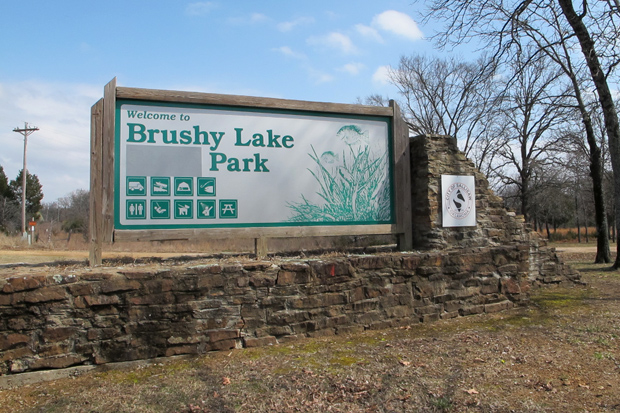
The word 'state' has been removed from Brushy Lake Park's entrance sign. The park, near Sallisaw, Okla., was transferred to the city's control in 2011.
Logan Layden / StateImpact Oklahoma


The word 'state' has been removed from Brushy Lake Park's entrance sign. The park, near Sallisaw, Okla., was transferred to the city's control in 2011.
Logan Layden / StateImpact Oklahoma

Logan Layden / StateImpact Oklahoma
The word 'state' has been removed from Brushy Lake Park's entrance sign. The park, near Sallisaw, Okla., was transferred to the city's control in 2011.
Oklahoma is facing a budget hole of more than $600 million dollars. And what looked like state agency cuts of 6.2 percent earlier this month, could double to around 12 percent to fill the gap.
To deal with the cut, the Tourism and Recreation Department is considering state park closures, and it wouldn’t be the first time.
After losing about a quarter of its appropriation between 2009 and 2012, the tourism department cast off seven parks. And last year, when dealing with a 5.5 percent cut, Walnut Creek State Park got the axe.
From CNHI state reporter Janelle Stecklein:
The state Tourism and Recreation Department, which oversees a $35 million budget and operates 34 state parks, hasn’t made decisions about the future of park funding, said spokeswoman Leslie Blair on Wednesday. But everything is on the table — including the closure of parks — if the department gets hit with an expected 6.2 percent budget cut.
“We’re going to have to weigh all the options,” Blair said. “We want to work with all parties involved and be able to give them as much notice as possible, but also know that we are facing significant challenges and have faced significant challenges.”
In 2014, when the state ended its lease with Walnut Creek State Park along Lake Keystone, StateImpact reported on its somber final weekend. It’s still unclear what will become of that park.
And when seven parks were slated for closure before being saved by local and tribal governments in 2011, one of the major complaints StateImpact heard was about how little input the tourism department sought from local authorities when making decisions about which parks to cut ties with.
“We, at least myself personally, heard about this in the newspaper,” Sallisaw City Manager Bill Baker told StateImpact in 2011, after hearing of the closure of nearby Brushy Lake State Park. “So we kind of felt like the state was pulling out of this and just leaving us holding the bag.”
Stecklein reports one Oklahoma politician wants to require the tourism department to give communities that rely on nearby parks more more advanced notice when closure decisions are being made.
Sen. Minority Leader Randy Bass, D-Lawton, wants to help communities thrown into that position in the future by requiring state leaders to notify their local counterparts at least 60 days before closing a park.
Bass said he filed his “Rural Tourism Protection Act” after watching his own community struggle when the unexpected news spread in 2011 that the local state wildlife refuge was on the chopping block.
“In the little rural communities, it’s terrible whenever you lose a park,” he said. In Lawton, as elsewhere, people came together to pay to keep the park’s gates open.
In an August 2014 interview with StateImpact, State Parks Director Kris Marek said she wishes parks were a bigger priority for the state, but they simply aren’t.
“There’s certain core services that are going to get the lion’s share of funds, and guess what, state parks isn’t on that list,” Marek said. “Many people might be surprised, but those advocates are not the ones that are lobbying at the Capital. In reality it’s education, it’s corrections, it’s roads, it’s things that people see as core services. Am I happy that a core service is not state parks? No.”